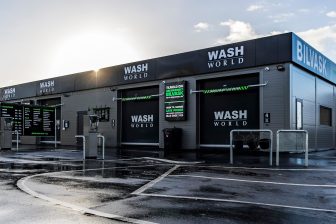
Ryan Essenburg (Tommy’s) predicts return of pay vacuums at car washes
The biggest trends in the car wash industry right now are cashless payment, a conversion to belt conveyors and the return of pay vacuums. Ryan Essenburg of Tommy’s Express Wash Systems discussed the trends in the industry during the Car Wash Show Europe. Watch his presentation here.
Many new car washes choose belt conveyors and pay vacuums, Ryan Essenburg states. The downside of free vacuuming is the high energy consumption and overflowing trash cans. Also, sometimes over half of the location’s floor space is used for a free service. So more and more car washes are starting out with or returning to with pay vacuums. “But the use of the vacuums is usual free for club members of a location”, Essenburg explains.
Ryan Essenburg is a third generation car washer. He is president of the global equipment manufacturer Tommy’s Car Wash Systems and founder of Tommy’s Express Car Wash. The franchise company has 66 locations in the USA. This February has been the busiest month ever for the company. One of the locations washed 63.000 cars in a 40 meter conveyor tunnel during this month.
Car Wash Show Europe
Essenburg was a speaker at the Car Wash Show Europe conference. His topic was current trends in the car wash industry. The manufacturer believes that the car wash industry is one of the best business opportunities today, which has only been amplified by covid-19. “People have a desire to be clean, to have a clean car.” And the industry has many reasons for longevity. “Think of the legal obligation to keep safety sensors on a car clean and the increased frequency in ride sharing, for which people want a clean car.”
Here is a short overview of what Essenburg lists as the trends. Watch his entire presentation below.
- Big box stores are being converted to express car washes, including interior vacuum centers.
Return of pay vacuums. - License plate recognition (LPR) has made other techniques such as with RFID and auto tellers obsolete. The accuracy is better and the technique works well with apps. The cell phone becomes the POS system.
- Cashless payment.
- Consolidation (in the USA): mid size companies are getting bigger and replacing independently working locations.
- Belt conveyors are coming up. Nearly all new washes have a belt conveyor. For the consumer it looks different and new, making chains obsolete in consumer eyers. What follows is a conversion from chain to belt. A big plus: more cars an hour can be washed.
- The rise of upscale express car washes that can process up to 2.000 cars per day.
- Density. Tommy’s has 4 locations within 5 kilometers of each other in hometown Holland, Michigan, and they’re looking at 6 locations in total for a population of 125.000 people. These locations contribute to each other’s success rather than compete.
- Franchising. Tommy’s has pushed this in the US. Benefits: proven processes, experience, benchmarking, centralized services.
- Attracting millennials: this is the largest customer base so take them into account. The biggest sales point for this group is convenience: make it easy.
Also read:



